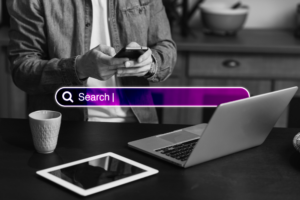The AIDA Model: what is it, and how will this strategy help your business to convert more customers?
Do you know the AIDA model? He has had more notoriety in recent years for his high persuasiveness, and as a result, conversion. It has been the secret that big companies and entrepreneurs use to achieve new results. It’s the ability to sell through words. Amazing, right? And what is the secret of the AIDA model? What is so magical about it that it takes countless people to make a decision after having contact with content in this format?
That’s what we’ll talk about in this article! Here, you’ll learn what the AIDA model is and how to use it to produce content that delights, generate value, and drive the persona of your business to take action. No matter what stage your business is at, you can use this template for a variety of purposes!
Content is the bridge that connects a persona to a brand. A survey by Hubspot in 2020,
reported that 70% of marketers are actively investing in content marketing, this data led us to think about 2 points:
- Marketers are constantly updating themselves and investing in strategies that are working. And professionals who are not in this area, but want to grow their companies digitally?
- What if, in addition to the more popular content marketing strategies, we include more techniques that have not yet been explored by marketers, such as neuroscience tactics?
From these questions, this content was born. The AIDA model mixes techniques from content and other areas, the result of this? High Conversion. We’ll talk more about this now!
Copywriting and AIDA: How to Sell More Efficiently
Copywriting is a writing technique that aims to guide your audience in making a decision. This decision can be a direct purchase or any other action that is part of this process: an idea, content, a service, among others. An important detail is that leading someone to a decision is not as easy as it sounds.
When trying to convince someone of the importance or why they should consume something, we tend to treat what we are offering as an object, rather than saying the benefits of it, we describe it as it is. Want an example, see:
Imagine that you want to invest in your health and decide to join a gym. Doing your searches, you will end up on the page of two gyms, A and B:
On the page of academy A, it says:
“Academy A is a space-based on __. Belonging to team __, which founded it in __. We are committed to developing your health through efficient equipment and coaches. Based on your health goals, the gym now offers equipment and experiences in more than 5 cities.”
On the academy B page, it says:
“We are in the midst of a transformation in the health area, a revolution has taken place in recent years: people have sought to have a better quality of life, and they understood that this transformation only happens through self-care. We at Academia B believe that by providing a welcoming space, with professionals who believe in this change and work leading our clients to this transformation, we will be able to bring a better quality of life to more people!”.
The description of academy B seems much more interesting than that of A, right? That’s because more than describing yourself. Academia B conveys its values and how it can change the lives of its clients. That is, she sells an idea. The idea of a new way of caring for the health, which associates self-care with a change in life.
But what does this have to do with copywriting and AIDA? Everything!
The AIDA model is one of the copywriting formulas, is a method focused on consumer behavior, considering that it is easier to guide you through the shopping journey.
Where did it come from?
This model was developed by publicist Elmo Lewis, who was one of the pioneers in communication and sales. North Americans developed this method in the 19th century, in 1899. From there, we see that it is a very old method, right?
But still, current, as years have passed, but it has not been outdated. Lewis wanted to optimize the sales process and decided to emphasize the relationship: seller, buyer, and product.
His goal with this process was simple: he believed that first, we need to get the consumer’s attention, then inform them about the product, and finally, turn them into a customer. The process took a while to evolve because there was a lot of stigma surrounding advertising at the time.
Over the years, the model evolved and the structure ended up changing: attracting attention, arousing interest, persuading, and convincing.
What is the AIDA model?
As we mentioned, the AIDA model is a writing method focused on consumer behavior, it serves to drive a customer forward and move him along the sales funnel. The acronym is the abbreviation of the initials of the words: Attention, Interest, Desire, and Action.
Each of the words describes how the customer behaves on the buying journey, and this cycle is essential for the lead to become a customer. On the journey, the consumer goes through several stages: first contacting the company, consuming the content produced, having their pain resolved, and finally, making a decision.
AIDA takes into account what the persona thinks, needs, and wants, and in this way optimizes the journey to reach more leads and generate more sales. That is:
- What does the lead think?
- What is his biggest wish?
- What does he need to close a purchase?
Answers will vary from business to business, from lead to lead. But let’s imagine an answer: the lead, right now, is thinking about how he can make more money on a low budget, so what he wants most is this: generate more sales and make more money – what does he need to close a purchase? Make sure his wish gets granted. With the answers to these questions, the steps can be elaborated more assertively, so that he gets to the final action.
The 4 steps: Attention, Interest, Desire, and Action
We saw that each letter means something, now we’ll see how each one acts in the shopping journey and how this method is in practice! Let’s go?
- ATTENTION
When was the last time something caught your eye right away? What catches our attention is forever imprinted on our minds. In the AIDA model, attention occurs when the public discovers your brand or what you offer. Do you know that sentence, the first impression is the one that stays? Yeah, it applies here.
Making a good first impression by speaking in AIDA language: getting attention in a strong way is important. If you’re not outstanding here, there may not even be a second chance. Even more, today, when everyone is receiving information all the time. If you don’t stand out in the middle of it all, no one will listen!
Getting attention means keeping people there, reading what you’ve written, or listened to what you’re talking about. There is not only one way to do this, there are several ways for you to explore, it all depends on your objective at the moment and your audience. That’s why it’s important to know your persona!
Knowing the language you will adopt and the subjects you will speak, you can use some strategies to help, such as:
- Use words that draw attention, for example, words that give a sense of urgency;
- Make a creative call, it can be with colors, funny phrases, characters that are of interest to your persona;
- Quickly deconstruct any objections the customer may have about your product or service
- INTEREST
Suppose you’ve already gained attention, now what? Well, now is the time to sell your fish, but not directly. You will talk about the product, but not describing its characteristics, but talking about how it can transform the customer’s life, what positive change it will bring to the person.
This is the moment when, if what the persona is looking for is clear and sharp in your product, curiosity will keep her there, wanting to understand a little more. Let’s give an example using this article, if you’ve come this far, it’s because you want to learn about AIDA, the first lines captivated you and you were interested to continue reading.
It is common that from Attention to Interest, the number of people has reduced. This is normal, after all, not everyone is interested in a certain topic. What you should focus on here is that those who remained to feel interested. Remember your persona is painful?
This is the time when you not only understand the pain, you also have a solution for it. This is the time when your potential customer must understand that they do have a problem. And they have a solution! Did you understand? Interest can be explored in a number of ways. Transformation and clear information are the best tactics.
- DESIRE
This is the moment when “I’m interested” should turn into “WOW! I want it!”, ok? If you’ve brought the person here, it’s a good sign, they’re closer to making a decision. So take this moment to show that what you have to offer is amazing! This is a good time to use some mental triggers, like social proof.
Remembering that, mental triggers are the stimuli that make our brain choose which path is easier to reach an ultimate goal. In this case, the social proof trigger will serve to show that other people have already trusted their work and that they have had good results with it.
Here is a good opportunity to talk about cases! Seeing that other people are already happy with what you offer, the customer may have more desire to get the same. To provoke this desire in people there is no crazy strategy, so far you’ve already talked a lot about everything you can offer.
Explore the benefits and features of your product or service that match the promise you made in the attention step. What about now?
- ACTION
And now we come to the grand finale! The moment of final action. In the action stage, all desire is turned into results. This outcome will depend on your goals, you may want the final action to be a webinar registration or a sale. Regardless of what it is, this is the stage at which the decision is short to be made.
Some things can drive the closing of the cycle, such as free trials, individual offers, discounts, among others. Some mental triggers can also help speed up this process, such as the urgency trigger. Example: This discount is only for today! The fear of losing the offer can be a little push for the customer to make the decision!
This will be the time when Call to Action (CTA) will also be used, they will tell people exactly what you want them to do. Which type of CTA you choose again will depend a lot on your business objective and audience. Some examples: Download now, Install now, Sign up, etc.
After this step, the AIDA method was successfully completed!
How do companies use AIDA in practice?
Attention, Interest, Desire, and Action. The 4 saviors of a persuasive and impactful text! Now that you know each of the points of this method, we will see in practice how large companies have used this formula and gained more customers! Starting with the attention.
- UBER: How does Uber get attention on social media?
On social networks, Uber always posts that right away grab the public’s attention! In this one, for example, the mental trigger of the connection was used, in a very assertive way, the company shared a value and in the caption, it spoke about the Her on the drive project.
On the company’s website, it is described that they “Create opportunities by setting the world in motion”. This description of opportunities serves both the drivers and the user, so that, without having to give explanations, they draw attention and connect with both.
This is an example of a company that knows how to get users’ attention and also connects with them!
- TRELLO: How does Trello capture our interest in a few seconds?
Trello is an organization platform. Remember we said that a good way to keep interested is by talking about what transformation it will cause in your life? Trello exploits this well! In a nutshell, the tool says you’ll be able to organize and prioritize your projects. And what transformation will this bring?
In addition to getting organized, all of this will be fun, flexible, and rewarding! Interest is activated here, after all, who doesn’t want to feel all these positive emotions?
- NUBANK: How did Nubank create a community quickly? Activating the desire!
Companies that create communities are the ones that most activate people’s desires, why? Because everyone wants to be a part of something amazing.
One such company is Nubank! In a short time, Nubank created a network of users who were flattered to have an account at that bank, and who didn’t want to open one, or at least know what was so special there! In this post, they brought a testimonial from a customer! Hello, social proof trigger, remember?
- AMAZON: How Amazon teaches an acting class in full time
If there’s one lesson from the AIDA model that we can learn from Amazon, it’s about action. The entire platform interface gives us the possibility to buy products quickly! Buying with one click, has become the darling of many customers. This practicality collaborates with the agility of the decision, remember?
The AIDA model can be applied to different businesses, from selling a product to some other objective, such as subscribing to a newsletter. It is a method of decision-making, as well as a model of communication. The guidelines it offers can be flexible or even used separately.
Now that you know AIDA, you can explore other copywriting formulas too! As we want you to be very successful, we will give you a bonus in this article.
Bonus: PAS, another success strategy you must use!
Copywriting has numerous good tactics that help in converting customers, in addition to AIDA, there is the PAS formula, which is also excellent to apply to content that seeks to give the customer a little push so that they go down a little further in the buying journey.
If AIDA is attention, interest, desire, and action, what is PAS?
The acronym PAS is the abbreviation of the initials Problem, Agitate, and Solution. In this formula, we raise any problem the reader may have, shake him up and finally propose a solution. One of the copywriting gurus, Dan Kennedy, said: “…people are more likely to act to avoid pain than to gain.”
There is the magic of PAS, avoiding pain and starting to find a solution is what many people want! So, leave it noted there:
- Problem: Identify the reader’s problem.
- Agitate: Agitate all painful emotions related to the problem.
- Solve: give a solution.
How to write a text in the PAS structure? Remember that every persona has a pain and a problem to solve. Identify what issue you are going to write about. That done, let’s go to the next topic: shake! Start listing all the scenarios that problems can lead to!
Is the problem investing in the wrong marketing strategies? This problem can lead to several worrying scenarios, for example:
- Loss of revenue;
- Unable to convert leads;
- Be blocked on some social network;
- Have the blog rank last on the Google page.
The more you explore possible scenarios, the better. After talking about the problem, lay out the consequences, in a fluid way, focusing on what the persona might miss and how that might hinder them from achieving the results they want. In this moment of agitation, you can use some mental triggers, such as:
- Pleasure vs. pain: reveal your client’s problem, show the two scenarios, the pleasurable one and the scenario in which the consequences of the problem appear, generating pain.
- Scarcity: generate tension and urgency, enjoy anxiety. Show him that he’s going to miss an incredible chance if he doesn’t solve the problem.
- Authority: yes, here you can show how you are an authority on the subject and how you know the consequences of the bad scenario.
Once you’ve shaken up the problem, it’s your chance to deliver what’s most valuable to the persona: the solution! After all, you told her everything bad that can happen, now is the time to teach her what to do so that none of that happens. At this point, you can indicate something or even offer a service.
It’s a good time to explore some other mental triggers, such as:
- Anticipation: You can tease your audience about what’s to come, work with expectations, and create a future scenario that consumers want to participate in. Like a webinar or event where you can help with a problem.
- Social proof: You can show that other people have already followed your tip or used your service and had good results, so the reader will also be curious to know more, and more confident to believe in what you offer.
- Exclusivity: This mental trigger awakens the snobbish side of the human being. If a person has exclusive access to information, a place, a product or another person, they tend to feel privileged. You can provide this unique information so that she feels she has a unique solution to a problem.
Well, you’re ready to take on the world with the copywriting, AIDA and PAS knowledge you’ve learned here! This is your time to apply in your business, ok? Remember that these are old techniques and they are very effective, so don’t be afraid to invest in them.
We hope this article has helped you! Did you like to learn about copy strategies, but don’t have the time or inclination to apply them in your business?
It’s not a problem!
We can apply them for you.
Contact Karis Marketing and learn more!







